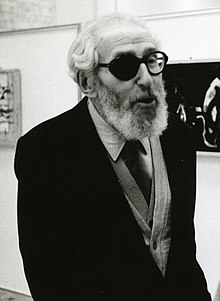Claude Aveline
You can help expand this article with text translated from the corresponding article in French. (July 2010) Click [show] for important translation instructions.
|
Claude Aveline | |
|---|---|
 Claude Aveline in an exhibition opening in 1989. | |
| Pen name | Minervois, Claude Aveline |
| Occupation | Writer, Poet |
| Nationality | Jewish |
| Genre | Novel, Poetry |
| Signature | |
Claude Aveline, pen name of Evgen Avtsine (July 19, 1901 – November 4, 1992), was a writer, publisher, editor, poet and member of the French Resistance. Aveline, who was born in Paris, France, has authored numerous books and writings throughout his writing career. He was known as a versatile author, writing novels, poems, screenplays, plays, articles, sayings, and more.
He was born to Jewish parents who had fled the racial segregation they were subjected to in Russia[1], moved to France in 1891 and became French citizens in 1905. Avtsine studied at the prestigious Lycée Henri-IV in Paris and then in a school in Versailles to which his parents moved. In 1915, he volunteered as a medic in the First World War, then went to college in Paris, but his health deteriorated and he had to stop his studies. In 1918 - 1919 he lived near the city of Cannes in southeast France, where he began writing under the pen name Claude Aveline.
In 1919, his poems were published in magazines, and he was introduced to writer Anatole France, becoming his protégé and close friend. In 1920, he returned to Paris, worked as an editor of an art journal, and accepted a request to write a book about Buddha, called "La merveilleuse légende de siddhartha gautama bouddha". In 1922, aged 21, he founded his own publishing house [2] under the name "Chez Claude Aveline éditeur" and was subsequently called "the youngest publisher in France".[3] and even "in the world".[4] In just eight years, he wrote a ten-volumes book collection, "Collection philosophique", with text from the works of Saint-Évremond, Voltaire, Denis Diderot, Ernest Renan, Anatole France, Remy de Gourmont, Maurice Maeterlinck, André Gide, Paul Valery and Georges Duhamel.
After another health incident in 1923, Aveline stayed four years in a health clinic in Font-Romeu, where he met and befriended a young patient, Jean Vigo, eventually becoming a film director. Aveline would later act both as the executor of the filmmaker's estate, and as the legal guardian of Vigo's daughter after his wife's death; in 1951 Aveline founded the Prix Jean Vigo given to young film directors. He was president of the jury board for twenty-five years.[5] In 1932 he published the detective novel "La Double Mort de Frédéric Belot", which was a public success, and in 1936, the novel "Le Prisonnier". Le Prisonnier has been cited by Albert Camus as an influence and inspiration for his successful novel, L'Étranger.[6][7] Favoring the left side of the political spectrum, he contributed to the writing of numerous communist and anti-fascist journals and publications, such as Commune and Vendredi.[8]
During the Nazi occupation in World War II Claude Aveline joined the French Resistance. In 1952 he won the Grand Prix of the Société des gens de lettres and the Prix Italia in 1955 for his creative work in radio dramas. In 1956, Aveline asked his many artist friends to artistically illustrate, i.e. draw or paint the Portrait de l'Oiseau-Qui-N'Existe-Pas (Portrait of the bird that doesn't exist), a poem he wrote in 1950, which was subsequently translated into 55 languages.[9] An anthology was made out of 108 portraits by artists of various backgrounds and styles such as Henri-Georges Adam, Atlan, Bertholle, Bissiere, Prassinos, Music, Singier, Vieira da Silva and Jacques Villon. In 1963 Aveline donated it to the Musée National d'Art Moderne in Paris where it was exposed. His bust, made in 1967 by Ossip Zadkine, was the last sculpture created by Zadkine before his death.[10] Aveline wrote «Je suis le dernier Zadkine» (I am the last Zadkine) in French newspaper Le Figaro, in homage to the artist.[11]
In 1974 he began writing memoirs. He died in 1992 in Paris.
References
- ^ Schoenbrun, David (1980). Soldiers of the night: the story of the French Resistance. Dutton. Retrieved 3 August, 2010.
{{cite book}}: Check date values in:|accessdate=(help); Cite has empty unknown parameter:|coauthors=(help) - ^ Fouché, Pascal (1983). Au sans pareil. Bibliothèque de littérature française contemporaine de l'Université Paris 7. Retrieved 3 August, 2010.
{{cite book}}: Check date values in:|accessdate=(help); Cite has empty unknown parameter:|coauthors=(help) Template:Fr - ^ Duhamel, Georges; Mahn, Berthold; De Villefosse, René Héron (1951). Chronique de Paris au temps des Pasquier. Union latine d'éditions. Retrieved 3 August 2010. Template:Fr
- ^ Feutry, Alain (1986). Camus lecteur d'Aveline: L'étranger contre Le prisonnier. Lambda Barre. Retrieved 3 August 2010.
{{cite book}}: Cite has empty unknown parameter:|coauthors=(help) Template:Fr - ^ Temple, Michael (2005). Jean Vigo. Manchester University Press. ISBN 9780719056321. Retrieved 3 August 2010.
{{cite book}}: Cite has empty unknown parameter:|coauthors=(help) - ^ Aveline, Claude (1989). Histoires nocturnes et fantastiques. Imprimerie nationale. Retrieved 3 August 2010.
{{cite book}}: Unknown parameter|coauthors=ignored (|author=suggested) (help) Template:Fr - ^ Humbert, Agnès (2008). Résistance: a woman's journal of struggle and defiance in occupied France. Bloomsbury. p. 331. ISBN 9781596915596. Retrieved 3 August 2010.
{{cite book}}: Unknown parameter|coauthors=ignored (|author=suggested) (help) - ^ Editions José Corti. "Claude Aveline". Retrieved 2 August 2010.
- ^ Canciani, Domenico; Aveline, Claude (1993). L'esprit et ses devoirs: écrits de Claude Aveline (1933-1956). Il Poligrafo. p. 284. ISBN 9788871150215. Retrieved 3 August 2010. Template:Fr
- ^ Zadkine, Ossip (1989). Musée Zadkine, sculptures, Volume 1989, Part 2. Paris Musées.
{{cite book}}: Cite has empty unknown parameter:|coauthors=(help) - ^ Claude Aveline (29/11/1967). "Le Dernier Zadkine". Le Figaro.
{{cite news}}: Check date values in:|date=(help)
